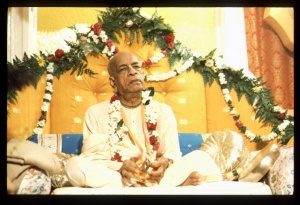CC Madhya 6.103 (1975)

A.C. Bhaktivedanta Swami Prabhupada
TEXT 103
- kṛṣṇa-varṇaṁ tviṣākṛṣṇaṁ
- sāṅgopāṅgāstra-pārṣadam
- yajñaiḥ saṅkīrtana-prāyair
- yajanti hi su-medhasaḥ
SYNONYMS
kṛṣṇa-varṇam—chanting the two syllables kṛṣ and ṇa; tviṣā—by complexion; akṛṣṇam—not blackish; sa-aṅga—accompanied by personal expansions; upa-aṅga—devotees; astra—the weapon of chanting the Hare Kṛṣṇa mantra; pārṣadam—and associates like Gadādhara, Svarūpa Dāmodara, etc.; yajñaiḥ—by sacrifice; saṅkīrtana—congregational chanting of the Hare Kṛṣṇa mantra; prāyaiḥ—chiefly consisting of; yajanti—worship; hi—indeed; su-medhasaḥ—those who are intelligent.
TRANSLATION
" 'In this Age of Kali, those who are intelligent perform the congregational chanting of the Hare Kṛṣṇa mahā-mantra, worshiping the Supreme Personality of Godhead, who appears in this age always describing the glories of Kṛṣṇa. That incarnation is yellowish in hue and is always associated with His plenary expansions [such as Śrī Nityānanda Prabhu] and personal expansions [such as Gadādhara], as well as His devotees and associates [such as Svarūpa Dāmodara].'
PURPORT
This verse from Śrīmad-Bhāgavatam (11.5.32) is explained by Śrī Jīva Gosvāmī in his Krama-sandarbha, as quoted by Śrīla Bhaktivinoda Ṭhākura in regard to the explanation of Ādi-līlā, Third Chapter, verse 52.